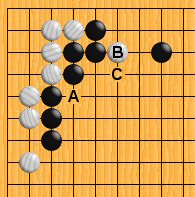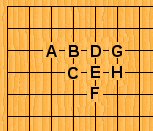
Game of Go – Concepts and terms
Aji, aji keshi and aji ga warui
The term 'aji' refers to latent threats or possibilities existing in a situation on the Go board. 'Aji keshi' refers to a play that removes or nullifies aji. Finally, 'aji ga warui' means bad aji, a position leaving aji for the opponent to use in the future.

In the situation on the left, a familiar joseki has been played out in the corner. Black is now free to play tenuki, but if he does, he leaves aji ga warui in the neighbourhood of A and C. If White plays at A, she cuts Black in two, and if she plays around C she threatens to revitalize her stone at B. It might be unwise for her to play here immediately, but depending on how the game develops she may decide to at some point in the future. If Black plays at A, the situation is aji keshi. So, although White gets very few points of territory from this joseki, and although she gets fairly well if not entirely shut into the corner, her compensation comes in the form of aji ga warui, if Black does tenuki, and in the form of sente, if Black plays aji keshi at A.
Corner points

A - sansan
B - komoku
C - hoshi
D - mokuhazushi
E - takamoku
F - gonogo
G - oomokuhazushi
H - ootakamoku
Compiled, developed and maintained by Philip Smith
